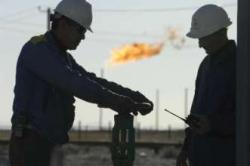Turkmen gas ambitions hinge on investment

Turkmenistan's ever-expanding oil and gas resources need serious investment if the Central Asian country is to realise its ambition of capturing growing world demand for energy, a Chevron Corp official said on Wednesday, Reuters reported.
A reclusive former Soviet republic holding the world's fourth-largest natural gas reserves, Turkmenistan plans to more than treble natural gas output by 2030.
"This is a relatively steep growth profile by anyone's standards," Douglas Uchikura, president of Chevron Nebitgaz B.V., said in a speech to an industry conference.
"Yet the approach you're taking is to try to do it yourself, without any long-term partnerships with experienced international oil companies."
Turkmenistan, a country of 5.4 million people, is seeking to lessen its dependence on gas sales to Soviet-era master Russia by opening up new supply routes into China, the European Union and Iran.
Oil and Gas Minister Bairamgeldy Nedirov said Turkmenistan was in talks with U.S., Russian and Chinese companies to secure the "significant investment" needed to produce 67 million tonnes of oil and 230 billion cubic metres of gas a year by 2030.
"What we're all trying very hard to understand is the degree to which 'vision' and 'opportunity' are effectively being converted into 'actuality' and 'achievement'," Uchikura said.
Baymurad Hojamuhamedov, the deputy prime minister with responsibility for the energy sector, presented new state data that showed Turkmenistan's onshore hydrocarbon resources had almost doubled in size since the start of 2006.
He said Turkmenistan's total hydrocarbon reserves as of Oct. 1, 2011, stood at 71.21 billion tonnes, including 53.01 billion tonnes of onshore resources and 18.20 million tonnes offshore, versus 45.44 billion tonnes as of Jan. 1, 2006.
Hojamuhamedov said Turkmenistan's total proved reserves of natural gas were 25.2 trillion cubic metres (tcm) as of Oct. 1.
The massive South Iolotan complex, when including the adjacent Yashlar and Osman fields, accounted for approximately three-quarters of the latest reserve total, he said.
Second-largest field
The auditor Gaffney, Cline & Associates has ranked South Iolotan as
the world's second-largest natural gas field after South Pars in
Iran, saying last month it could contain between 13.1 trillion and
21.2 trillion cubic metres.
The Yashlar field could hold up to another 5 tcm, it said.
Uchikura said Turkmenistan could become a key supplier to meet incremental demand growth in many markets, but that the country should move quickly to beat competition from other suppliers, especially as the role of LNG and shale gas grows.
"Other gas producers will compete aggressively for the same markets. So, if you keep that in mind, it may not be all that important that we continue to hear the resource numbers for South Iolotan-Osman are climbing," he said.
The absence of any firm production commitments has long been a source of frustration for Western energy majors enticed by Turkmenistan's oil and gas resources.
Although companies such as Malaysia's Petronas and Dubai-based Dragon Oil have been drilling for years on the Caspian Sea shelf, Chinese state-owned CNPC is still the only foreign firm with an onshore production sharing agreement.
CNPC has invested $2.3 billion to date at the Bagtyyarlyk deposit and plans to build second gas-processing plant there by 2013, CNPC Turkmenistan General Director Lu Gongxun told the conference.
Uchikura said partnerships between international oil majors and host governments in countries with similar ambitions to Turkmenistan had worked better than the "do-it-yourself" model.
Turkmenistan's production growth, he said, was premised on deep, sub-salt reservoirs with higher pressure and temperatures than experienced on any large scale in the country. The cost of building pipelines could also run to another $100 billion.
Pipeline politics
Uchikura said Turkmenistan's annual gas production capability had
averaged around 70 bcm in the 20 years since independence from the
Soviet Union.
Production dropped sharply in 2009, however, during a dispute with Russia over a pipeline rupture.
China has taken up some of this slack. Turkmenistan has pumped nearly 17 billion bcm through a 2,000-km (1,250-mile) Central Asian pipeline to China that opened in late-2009, and annual supplies are forecast eventually to reach 60 bcm.
Turkmenistan also plans to supply gas westward to Europe by building a pipeline under the Caspian Sea to Azerbaijan, a route that would reduce European dependence on Russian gas.
The European Union-backed plan has drawn fierce criticism from the Kremlin, which argues that a trans-Caspian pipeline should be approved by all five Caspian littoral states, including Russia.
In a show of U.S. support for the project, an official from President Barack Obama's administration said producer countries, including Turkmenistan, should make their own independent choices with regard to their energy resources.
"If Turkmenistan and Azerbaijan agree on construction of such a pipeline, no other country has veto power over that decision," said Daniel Stein, senior advisor to the U.S. State Department's office of the special envoy for Eurasian energy.
